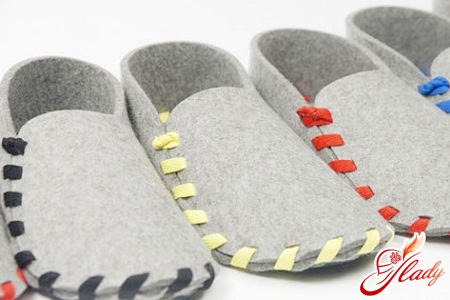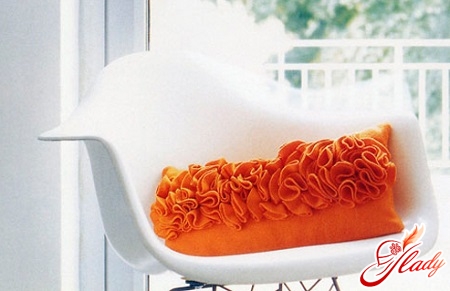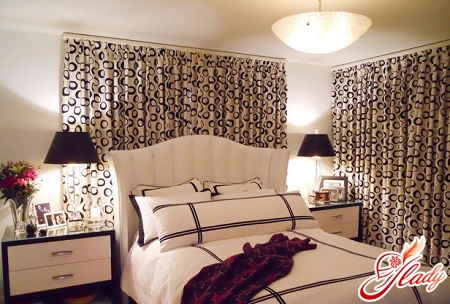
Many women are not strangers to desiresew your own curtains for your bedroom or living room, or a curtain for the kitchen. Curtains allow you to realize your aesthetic idea or test your creative potential, and the ease of implementation does not require any special skills. Our tips and recommendations will help you create a product that will be able to become a bedroom decoration and fully perform its assigned functions.
Principles of fabric choice
Having decided to sew curtains with your own hands forbedroom, it is necessary to solve a number of issues, such as the choice of style, color and texture of the fabric. Before going to the fabric store, it is necessary to understand for yourself what main functions the curtains perform in the bedroom. They are not only an element of decor, but are also designed to hide the rest room from prying eyes. This fact is at the forefront of choosing fabric for curtains, in addition, it is worth considering a functional option that can create an atmosphere of calm, harmony, coziness, security and comfort in the bedroom. The main requirements include:
- Aesthetic look.
- Increased tissue density, which prevents the penetration of street light.
- Combination with the design of the room according to texture, color and style.
- Functionality.
Because curtains are meant to protect usfrom unwanted noise and glances, it is worth giving preference to heavy and dense fabrics that can be combined with thin tulle or translucent light veil. This advice is relevant if the bedroom windows face east or south. It is worth noting that this rule is not considered a dogma, especially if it does not get along with the chosen style and interior of the bedroom. When considering this or that fabric option for future curtains, do not forget about such a concept as environmental friendliness. Choose natural materials or those that are easy to clean and care for. Light curtains can be made of cotton, silk, calico or linen, for dense ones, choose velvet, heavy silk or velor. Choose brocade, velvet, blinds if the bedroom windows overlook the sunny side, a noisy courtyard or a busy road. If you are not afraid of a bright sunny morning and noise outside the window, opt for lighter fabrics, such as organza, silk, chiffon. When choosing the color of the fabric for the curtains, focus on the overall color scheme of the room. Light shades - beige, sky blue, caramel, light pink, light green - go great with light furniture. Curtains in deep saturated shades are suitable for massive dark furniture. The pattern on the curtains is designed to emphasize the individual style of the room, and not distract attention. Thanks to the transverse stripes, you can visually expand the space of the room, while vertical ones will help to overcome such a disadvantage as a low ceiling. If the main attention should be drawn to the bed, sew curtains from the same material as the bedspread on it, or at least a similar color. By complementing the interior with pillows, you will get a single stylistic ensemble. Bright curtains will be relevant for hi-tech and minimalism (of course, provided that the room is done in cold and light colors).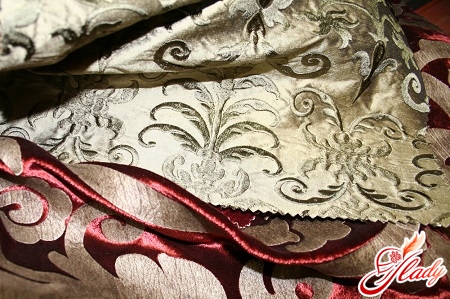
Choosing a design for curtains
When choosing curtains for the bedroom, the main thing isharmonious combination of interior components. The ideal option is considered to be one that involves using a bedspread, curtains and decorative pillows made of the same textile. But if this is not possible, at least the style of the elements should remain uniform. For the bedroom, various types of curtains will be relevant, which will differ not only in color and texture, but also in the sliding mechanism. Roman, English and roller blinds are elegant and compact. French and Austrian models look more magnificent when raised. They are able to add pomp to the room, so they are most often used for the living room or for a large bedroom. Fans of the classic style will like both sliding curtains and Italian curtains made of thick fabric. Such a curtain is not very difficult to make yourself, since it is a rectangular piece of fabric, gathered diagonally into folds using cords and rings located on the back of the curtain. Roman blinds are also considered classics, as they combine modern practicality and classic elegance. Both light and thick fabrics can be used for their production. The use of various fabrics and sewing methods allows the curtain to acquire the appearance of horizontal blinds. The choice in favor of such curtains should be made if we are talking about small bedrooms, since they, like no other, are able to save space. The Japanese style in modern space design is becoming increasingly popular. The advantage of such curtains is the possibility of using them on different windows, as well as in the use of fabrics of various textures. An original solution would be to use different materials that differ not only in color and texture, but also in density.
The process of sewing curtains
Having chosen the fabric for the curtains and the necessary elementsfor accessories, you can proceed to the stage of sewing the product. Sewing any product involves taking measurements and cutting. In the case of curtains, you need to determine their length and width, cut off the required fabric. Remember about a small reserve, which is 10-15 cm in width and up to 30 cm in length. In this case, the proverb "measure seven times, cut once" is more relevant than ever. In case of an error, you will have to make every effort to correct it, and sometimes this may be impossible. Marking in professional workshops is done on special tables, in the case of sewing curtains for the bedroom with your own hands, this role can be played by the floor. All marking actions are performed using a special tape measure, straight lines can be outlined with thin chalk or a piece of soap and a meter-long wooden plank or ruler. Before stitching the seams, iron the fabric. Thanks to this simple action, the edges will become even, which contributes to more confident and convenient work. If you have no previous experience with a sewing machine, try to keep the edge of the fabric in sight. If the curtain model you have chosen involves the use of decorative tape, take two strips 15 cm long and the chosen one, remembering to leave a 2.5 cm allowance. Fold them in half lengthwise and sew, making a grab and a decorative tape. Then cut a strip 21 cm long, fold it in half lengthwise, sew and turn it inside out. Cut into three pieces 7 cm long. Fold the raw edges of the strip and sew them to the curtain in the form of loops: one in the center and two at the edges. Pass the decorative tape through these loops and sew its ends to the side edges of the curtains. After that, move the curtains to one side and use the grab to fix the drapery. Attach the grab to the wall using a hook or Velcro.
Sewing curtains with a lambrequin
The term "lambrequin" refers to the upper partcurtains, which are a kind of connecting link between the halves of the curtain. The lambrequin is not only assigned an aesthetic function, it is also designed to improve the protection of the room from the penetration of sunlight. To create such curtains, it is necessary to accurately calculate the width of the lambrequin in the cut, for this, the width of the cornice is multiplied by the selected fold assembly coefficient. If we are talking about one-sided folds, multiply by 3 and do not forget about the allowance of 5-6 cm, which will be needed for processing the seams and shrinkage. Such a lambrequin can have a different shape of the bottom: hem or bias tape. A regular drapery tape is sewn to the top. Using patterns for the base, you can cut and sew a lining, which will make the structure denser. To create curtains yourself, you will need a number of tools and materials:
- clips on which the curtains are held;
- the cloth;
- accessories and cornice;
- thread;
- pins;
- sewing machine;
- subjects for measurement;
- scissors;
- bar length of 1 m;
- iron.
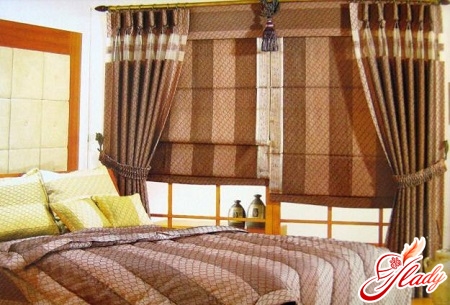
Sewing of Roman curtains
For sewing Roman blinds, it is recommended to choose dense fabrics that hold their shape well. You will need a number of tools that will help make your idea a reality:
- Rack, which must be shorter than the length of the curtain;
- finishing tape - "Velcro" and braid;
- small nails;
- plastic or metal rings with a diameter of 12 mm;
- Nylon cord length is equal to two lengths of curtains and one width.
To make Roman blinds, measure the widthwindow, which will be the width of the future curtain. To the resulting number, you need to add 5 cm. The length is determined by the height of the window with an allowance of 12 cm for a double hem along the bottom edge and a seam along the top. On the ironed fabric, from the wrong side, mark the hem lines, fold location lines and ring sewing points. For the first fold, a distance equal to ½ the fold width is set aside from the bottom edge line. All subsequent lines are located at the same distance, which is the fold width. Further work on creating curtains includes:
Alternative way to create curtains
If you don't have a sewing machine at home, this is notmeans that you will not be able to realize your creative potential. An alternative method would be to use the gluing method, which is based on the use of special adhesive tape, which is easy to buy in sewing supply stores. Before use, the tape is measured and cut based on the length and width of the curtain. Then the tape folded into the seam is ironed according to the instructions. Curtains created in this way are not inferior to their stitched "brothers" in either aesthetic or functional characteristics.






